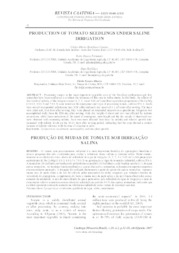Production of tomato seedlings under saline irrigation.
Production of tomato seedlings under saline irrigation.
Summary: Processing tomato is the most important vegetable crop of the Brazilian agribusiness and few researches have been conducted to evaluate the tolerance of this crop to saline stress. In this study, the effects of five levels of salinity of the irrigation water (1, 2, 3, 4 and 5 dS m-1) and three equivalent proportions of Na:Ca:Mg (1:1:0.5, 4:1:0.5 and 7:1:0.5) were tested on the emergence and vigor of processing tomato, cultivar IPA 6. Seeds were sowed in expanded polystyrene tray (128 cells) and each tray received 1 L of water after sowing. The trays were piled and, four days after sowing, they were placed on suspended supports in a greenhouse. Irrigation was accomplished daily from the fifth day after sowing. Only dry weight of shoot and root was affected by sodium proportions, while linear reductions of the speed of emergence, stem length and the dry weight of shoot and root were observed with increasing salinity. Root was more affected than shoot by salinity and relative growth ratio increased with salinity levels on the 14-21 days after sowing period, indicating that the crop showed a certain increase of salinity tolerance with the time of exposure to salts.
Publication year: 2007
Types of publication: Journal article
Unit: Embrapa Mid-North
Observation
Some of Embrapa's publications are published as ePub files. To read them, use or download one of the following free software options to your computer or mobile device. Android: Google Play Books; IOS: iBooks; Windows and Linux: Calibre.
Access other publications
Access the Agricultural Research Database (BDPA) to consult Embrapa's full library collection and records.
Visit Embrapa Bookstore to purchase books and other publications sold by Embrapa.

